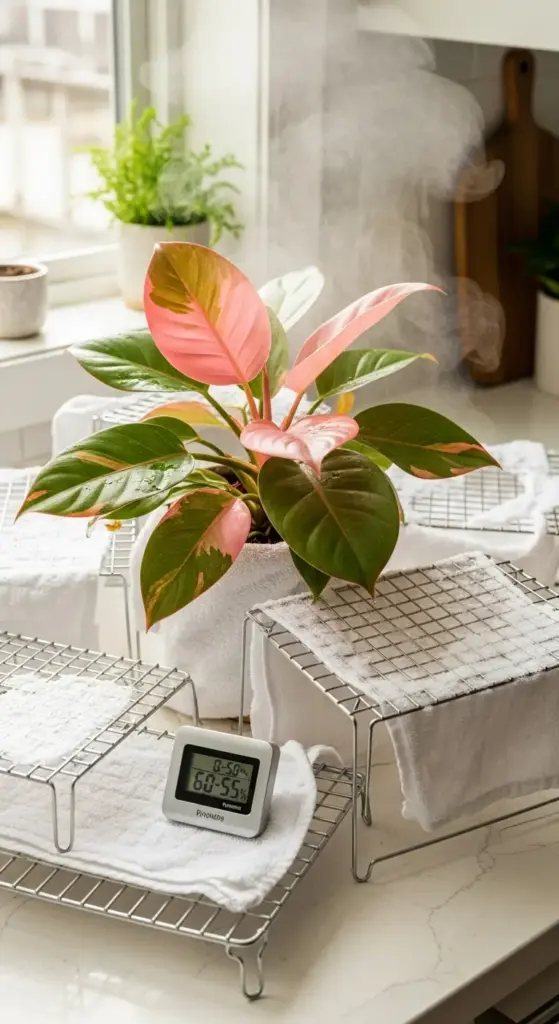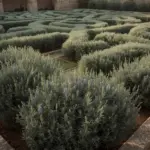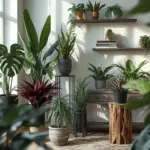2. The Underground Humidity Hack Using Household Items

Let me share the humidity hack that literally saved my Pink Princess from becoming a $150 crispy leaf disaster. This method uses stuff you probably already have in your kitchen, and it works better than those fancy humidifiers everyone raves about.
I was so frustrated with my plant’s brown leaf edges that I almost gave up on houseplants entirely. Then I discovered this game-changing technique.
Why Traditional Pebble Trays Are Actually Useless
Here’s the truth nobody wants to admit: pebble trays don’t do jack for humidity. I wasted months with those pretty little stone setups, watching my Pink Princess slowly crisp up while I convinced myself it was working.
The problem is simple physics. Those trays only increase humidity in a tiny bubble right above the water surface.
Your plant sits way above that microscopic humid zone, getting basically zero benefit. It’s like trying to humidify your entire bathroom by leaving a shot glass of water on the counter.
I measured the humidity around my pebble tray setup with a hygrometer – it was still only 35% at plant level. Total waste of time and counter space.
The Kitchen Item That Changed Everything
Dish towels became my secret weapon. Not kidding – those basic cotton kitchen towels you use for drying dishes are humidity goldmines.
Here’s my setup: I take a large, clean dish towel and soak it completely in distilled water. Then I wring it out until it’s damp but not dripping.
I drape this damp towel over a wire cooling rack (the kind you use for cookies) and place it right next to my Pink Princess. The evaporation surface area is massive compared to a tiny water dish.
Creating Micro-Climates That Actually Work
The towel method creates what I call a “humidity bubble” around your plant. The key is positioning multiple damp towels strategically to surround your Pink Princess without crowding it.
I use three medium-sized towels on cooling racks, forming a loose triangle around my plant. This creates a consistent 60-65% humidity zone that my hygrometer confirms actually works.
The best part? You can adjust the humidity by using more or fewer towels, or by how damp you keep them.
During dry winter months, I add a fourth towel. In summer when my house is naturally more humid, I scale back to just two.
The Towel Technique That Maintains Perfect Humidity
Consistency is everything with this method. I refresh my towels every 2-3 days, or whenever they feel mostly dry to the touch.
The trick is using distilled water only. Tap water leaves mineral deposits on the towels that can harbor bacteria and create weird smells.
I keep a spray bottle filled with distilled water nearby for quick touch-ups. A few spritzes on the towels every morning keeps the humidity steady all day.
Pro tip: Use white or light-colored towels so you can easily spot any mold or discoloration that might develop.
Preventing Fungal Issues While Maximizing Moisture
This was my biggest fear when I started the towel method – creating a fungus paradise around my expensive plant. But proper air circulation solves this completely.
I position a small fan about 6 feet away, set on the lowest speed. This creates gentle air movement that prevents stagnant, humid air from sitting around the plant.
Never point the fan directly at your Pink Princess – that’ll dry it out faster than you can say “crispy leaves.”
The key is keeping the air moving just enough to prevent fungal spores from settling, but not so much that you blow away all your carefully created humidity.
Budget-Friendly Alternatives That Actually Work
This entire setup cost me less than $25. Three cooling racks from the dollar store, some basic cotton towels I already owned, and a small desk fan from a thrift shop.
Compare that to the $200 ultrasonic humidifier I almost bought, which would’ve humidified my entire living room (and probably caused mold issues in my walls).
Another hack I discovered: large shallow baking dishes filled with wet sponges. The sponges provide tons of surface area for evaporation, and you can squeeze them out and refresh them easily.
For extra humidity during really dry spells, I add wet paper towels draped over plant stakes around the pot. Looks a bit weird, but it works amazingly well.
The Results That Blew My Mind
Within two weeks of starting this towel system, my Pink Princess stopped developing brown leaf edges completely. The new growth came in glossy and perfect, with vibrant pink variegation.
I actually measured a 30% increase in humidity around my plant compared to the useless pebble tray method. My hygrometer consistently reads 62-68% in the plant’s immediate area.
The best part? My heating bill didn’t go up like it would with an electric humidifier running constantly.
Why This Method Beats Expensive Equipment
Humidifiers are overkill for single plants, and they can create problems you don’t want. Too much humidity in your living space can cause mold in walls, condensation on windows, and other issues.
The towel method gives you precise, localized humidity control. You’re only humidifying the exact space your plant needs, not your entire house.
Plus, when you travel or forget to maintain it for a few days, the worst that happens is the towels dry out. No broken equipment, no flooded floors, no electrical issues.
Think humidity is tricky? Wait until you see the fertilizer formula that most plant stores don’t want you to know about. Click “next” to discover the exact NPK ratio that triggers explosive pink variegation – this secret ingredient costs less than $5 and will transform your feeding routine forever!









GIPHY App Key not set. Please check settings